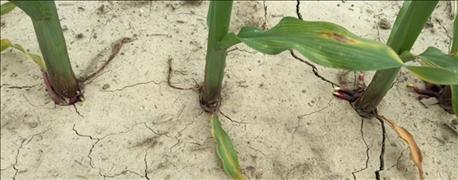July 14, 2015

Disease has proved to be a threat this growing season in Indiana. With the past month of rain, cloudy days, and moderate temperatures, disease spores are set up for perfect growing conditions. Northern corn leaf blight is developing quickly and making an appearance that farmers should be concerned with.
Scout's Report 7/9: Diseases making an appearance in Indiana
According to Purdue University Extension, the time to worry about this disease affecting yield potential is when the lesions have worked their way up to the ear leaves before pollination.

Due to over-saturated soils that may have dried out, brace roots are unable to penetrate soil
There's a possibility of hybrid corn yields falling by 30% if NCLB takes away photosynthetic potential at or right before tasseling. Aside from the loss of leaf area and photosynthetic action, NCLB can play a role in stalk rot.
NCLB should be monitored in relation to growth and reproductive stages of corn. Management by use of fungicide may be needed after pollination. Fungicides have the capacity to slow the spread of NCLB, but can't kill all spores and stop the disease in its tracks.
Spraying can give about another two weeks of growing time for the plant, but will not totally control the lesions' ability to grow and spread up the plant.
Gray leaf spot and Holcus leaf spot
Gray leaf spot and Holcus leaf spot are still present and growing in Indiana corn as well. Holcus spots should be monitored but usually don't have potential to affect yield or diminish plant health. Gray leaf spot has become fairly heavy in the lower canopy of many corn fields.
Wet conditions in addition to the lack of sunshine have created a perfect breeding place for the disease. GLS has not previously proved to be as dangerous as NCLB, but does limit the photosynthetic activity for corn.
Scout's Report 7/1: European corn borer feeding begins in Indiana
Due to over-saturated soils that may have dried out, brace roots are unable to penetrate soil. Areas that have dried have left a very hard top layer which is too tough for most brace roots to establish. The concern with this issue is the ability of the plant to remain standing once the weight of an ear is present.
~~~PAGE_BREAK_HERE~~~
Corn borers
Corn borers are still eating at non-GMO crops. The insects can damage plants and move on to the next ones down a row, leaving behind damaged tassels that are wrapped in the whorl. Controlling the spread of these borers is a very timely task. Catching the egg masses before they hatch is key. Spray an insecticide before larvae that hatch have a chance to burrow down into the stalks.
The traps throughout north central Indiana have shown the next wave of European Corn Borer moth flight action. I have found 11 moths this week and expect those to be laying egg masses soon for the next generation to attack fields.
Check Purdue Entomology and Agronomy updates for more information. Look for my findings again next week!
Kettler is a Purdue University Agronomy student. She writes form Tipton. She is interning as a scout with Beck's Hybrids this summer. She works closely with Ben Grimme, Kris Johnson and Denny Cobb, all Beck's Hybrids staff members.
You May Also Like




